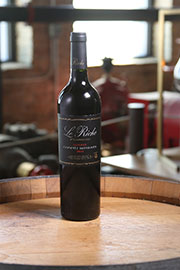- Analysis
- Vineyards
- Vinification and Aging
- Tasting Notes
- 2014 Vintage Notes
2012 Cabernet Sauvignon Reserve
Wine of Origin
Stellenbosch
Varietals
100% Cabernet Sauvignon
Analysis
Wine Maker: Christo Le Riche
Alcohol: 14.%
Total Acidity: 5.6 g/l
pH: 3.68
Residual Sugar: 1.0 g/l
The grapes are selected from top growers in Stellenbosch. A combination of soil, climate, clones and vine age determine the vineyard blocks selected. With meticulous viticulture and a focus on canopy microclimate and soil health, we try to ensure that each vineyard can express itself to its full extent. Vineyard blocks are vinified separately to determine their quality and style, ensuring that their unique character is understood and shown.
Within Stellenbosch, the majority of the fruit comes from two soil types – decomposed granite soils higher on the mountain slopes and sandy gravel on the valley floor. Most of our vineyards are close to the ocean, providing a cooling breeze in the afternoon during the hot summer months. These vineyards are also on sandy gravel soils that warm up fast during budding and provide us with earlier ripening grapes. The decomposed granite soils are mainly higher on the mountain slopes where the altitude helps to cool the vineyards. These soils bud and ripen later in the season. Other soils include decomposed shale and the warmer slopes of the Bottelary Hills.
Reserve status is only endowed if the grapes and resulting wine measures up to exceptional standard. Hand selected grapes from older, lower yielding vines are used. Fermentation is done with a selected yeast strain under controlled temperatures. Manual plunging during this period ensures optimal color extraction.
After five days the tanks are closed and allowed to macerate for a further period, normally 10-14 days. Pressing follows and the wine is transferred to barrel for the secondary (malolactic) fermentation. On completion a final quality check and analysis is performed and the Reserve is then prepared for barrel aging. The oak regimen is precisely 24 months in 67% new French oak barriques. Bottling is followed by hand labeling and further bottle maturation.
Aromas of sweet black cherries are balanced by hints of mint and cedar. The palate shows classy Cabernet flavours and soft, supple tannins with a firm structure. The rich, juicy entry is followed by an elegant mid-palate and long, lingering finish. The Reserve is best enjoyed with simple dishes, where the wine can be the star of the meal.
The season started with an early and even bud-break due to a cold and dry winter. Spring was cool and dry helping the vineyards to grow slowly and without pressure from disease. A cool October and early November had high rainfall levels (70mm) with intermittent winds that damaged the Cabernet flowers resulting in a smaller than usual crop due to weak fruit set. Mildew populations were prevalent and their pressure remained until mid – December.
The period after flower set to veraison was good with a warm and less windy December. This is the most important time for flavor development. We were able to open up the canopies and expose the berries to early sunlight, helping them to develop their own “sunscreen” for the summer with higher tannin production. Low water levels persisted throughout the vintage, reducing the vine vigor and berry size.
January had two heat waves with temperatures of over 35°C, but it was early enough in the season for the Cabernets to recover. This warm weather also helped to reduce green flavours. A cool February slowed the berry ripening and resulted in a harvest that started 1-2 weeks later than usual. This assisted in developing good fruit and tannin ripeness at lower alcohol levels with good acidity.
All in all it was an outstanding season resulting in wines with elegance, vibrancy and freshness. Definitely a contender for vintage of the decade.

